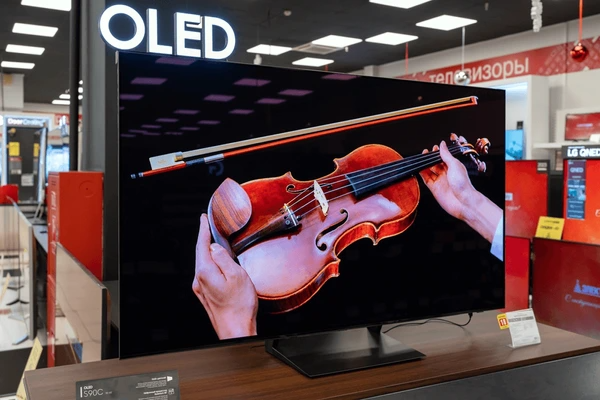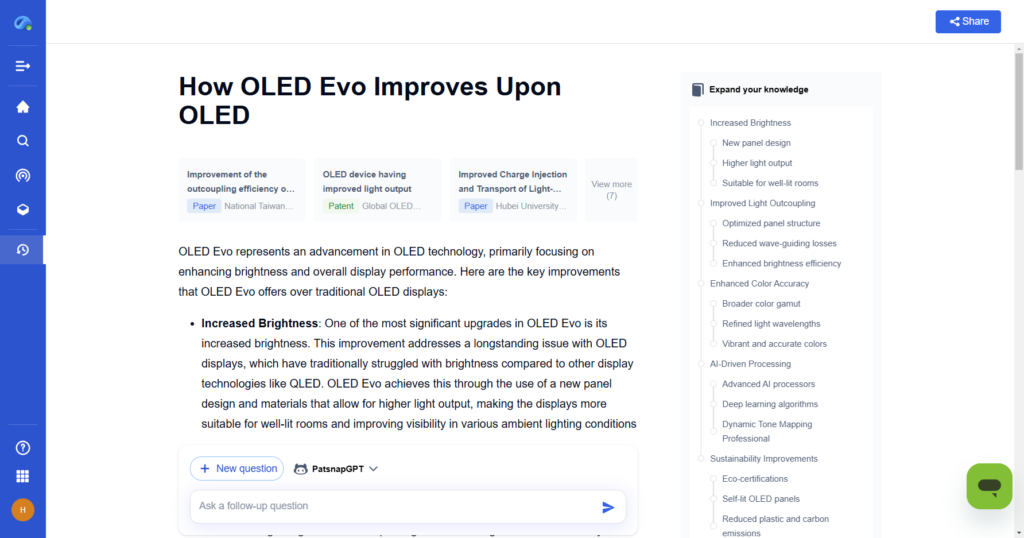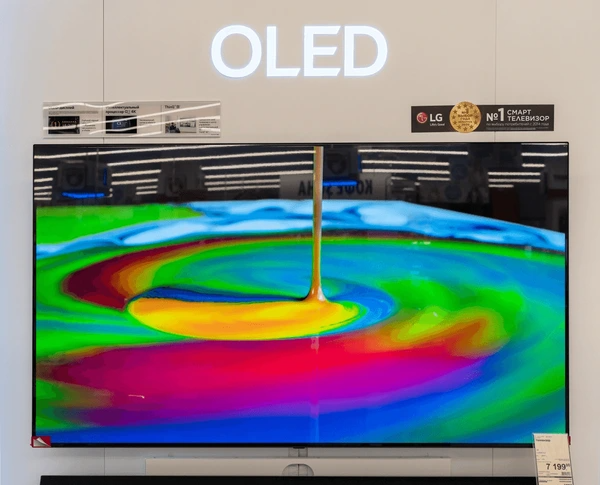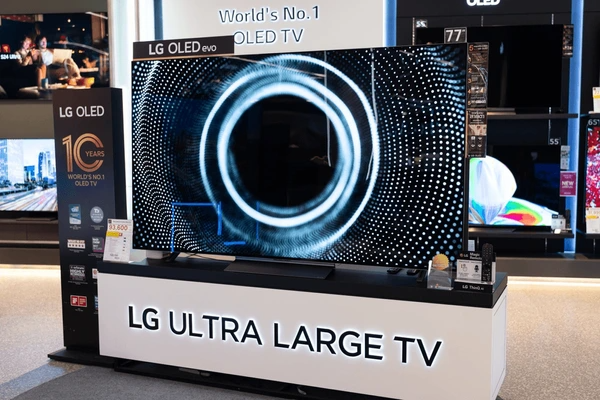
Overview of OLED and OLED Evo
When it comes to cutting-edge display technology, OLED and OLED Evo are two terms that often come up. Both offer stunning picture quality, but they have key differences that can affect your viewing experience. OLED displays are known for their vibrant colors, deep blacks, and wide viewing angles. OLED Evo builds on these strengths with improved brightness and enhanced performance. In this article, we’ll explore the differences between OLED vs. OLED Evo, examining their features, benefits, and helping you decide which one suits your needs best.
How OLED Works
Curious about how OLED Evo enhances traditional OLED technology? Eureka Technical Q&A provides expert insights into its improvements in brightness, color accuracy, and efficiency, helping you understand why it offers a superior viewing experience.
OLEDs, or Organic Light-Emitting Diodes, are light-emitting devices made up of organic materials. These materials are sandwiched between two electrodes: an anode (positive electrode) and a cathode (negative electrode). When voltage is applied, electrons flow from the cathode, and holes (positive carriers) flow from the anode. The electrons and holes recombine in the organic layer to form excitons, which are excited states of the molecules. As the excitons relax, they release energy in the form of light.
Emission Mechanisms in OLEDs
- Fluorescence: This is the simplest mechanism. Singlet excitons (excited states with a total spin of 0) emit light when returning to the ground state. However, only 25% of excitons in this state are used for light emission, while the remaining 75% are in a triplet state that doesn’t emit light.
- Phosphorescence: In this type of OLED, both singlet and triplet excitons are used for emission. Special metal complexes like iridium or platinum help triplet excitons transition to the singlet state, allowing for nearly 100% efficiency.
- Thermally Activated Delayed Fluorescence (TADF): TADF is a newer mechanism where the energy gap between singlet and triplet states is minimized. This allows the triplet excitons to efficiently convert to singlet states, enhancing overall efficiency while still using fluorescent materials.

OLED Device Architecture
- Emissive Layer: This is where electron-hole recombination occurs, and light is emitted.
- Charge Transport Layers: These layers help transport charge carriers to the emissive layer, ensuring proper function.
- Blocking Layers: These layers confine excitons to the emissive layer, improving the efficiency of light emission.
How OLED Evo Improves Upon OLED
How does OLED Evo improve upon OLED? Eureka Technical Q&A highlights its enhanced brightness, color accuracy, and efficiency for a superior viewing experience.

Increased Brightness
OLED Evo panels are designed to achieve higher brightness levels than standard OLEDs. This improvement addresses a key OLED limitation, making them perform better in bright rooms. It also enhances the viewing experience, especially for HDR content.
Improved Color Accuracy
OLED Evo panels use advanced materials and processing techniques to improve color accuracy. As a result, they deliver more vivid and lifelike colors, elevating the overall visual experience.
Energy Efficiency
With optimized panel and processing technology, OLED Evo enhances energy efficiency. This allows the display to provide better performance while consuming less power compared to earlier OLED generations.
Enhanced Durability
LG’s OLED Evo technology introduces new heat dissipation systems to prevent burn-in. This upgrade extends the panel’s lifespan, ensuring long-lasting picture quality, even in high-brightness environments.
Innovative Panel Design
OLED Evo features an additional layer of emissive material. This design refines light wavelengths, improving both brightness and efficiency. As a result, the panel offers superior light management and performance in various viewing conditions.

Practical Applications of OLED and OLED Evo
Display Technology
- TVs and Monitors: OLEDs are popular in TVs and monitors due to their high contrast ratio and wide viewing angles. They also provide deep blacks, making them ideal for an immersive viewing experience.
- Mobile Devices: OLEDs are commonly found in smartphones and tablets, offering vibrant colors and improved energy efficiency over traditional LCDs.
Lighting
- Ambient Lighting: OLEDs are used in ambient and accent lighting because they emit diffused light and provide uniform illumination.
- Signage: OLEDs are also employed in signage, both indoor and outdoor. Their high brightness, wide viewing angles, and dynamic content capabilities make them perfect for this application.
Wearable Technology
Smartwatches and Fitness Trackers: OLEDs are ideal for wearable devices due to their low power consumption. They can also display clear images and text even under bright sunlight.

Automotive
Instrument Clusters and Displays: OLEDs feature in car dashboards and infotainment systems because of their high contrast ratio and wide viewing angles. They can also display 3D graphics, enhancing the driving experience.
Augmented Reality (AR)
AR Headsets: OLEDs are well-suited for AR headsets due to their fast response time, high brightness, and ability to display high-quality images.
Should You Choose OLED vs. OLED Evo?
When it comes to choosing between OLED and OLED Evo, it really depends on your specific needs and priorities. Both offer exceptional visual quality, but OLED Evo takes it a step further with some notable improvements. Here’s a breakdown to help you decide:
Brightness and Performance
OLED displays already provide excellent contrast and color accuracy. However, OLED Evo boosts brightness levels, which is perfect for bright rooms or HDR content. If you often watch TV in a well-lit space, OLED Evo could be the better choice.
Color Accuracy
Both OLED and OLED Evo deliver stunning colors, but OLED Evo incorporates new technologies that refine color reproduction, offering a more vibrant and true-to-life experience. If you want the most accurate colors, OLED Evo might be worth the investment.
Energy Efficiency
OLED Evo improves energy efficiency compared to standard OLED. With its optimized panel and processing technology, OLED Evo can give you better performance without consuming as much power. This is especially important for those who are energy-conscious.

Durability and Lifespan
Burn-in concerns can affect both OLED and OLED Evo, but OLED Evo’s enhanced heat dissipation system helps reduce the risk. It also improves the lifespan of the panel, making it a more durable option for long-term use.
Overall Value
If you’re looking for a TV or display with excellent all-around performance and don’t mind spending a bit more, OLED Evo might be the right choice for you. On the other hand, if you’re on a budget and can forgo a little extra brightness and energy efficiency, a standard OLED display will still provide an amazing viewing experience.
In the end, your decision should be based on factors like viewing conditions, energy preferences, and how much you’re willing to invest in the latest technology. Either way, both OLED and OLED Evo offer stunning displays that will enhance your viewing experience.
To get detailed scientific explanations of OLED vs. OLED Evo, try Patsnap Eureka.


